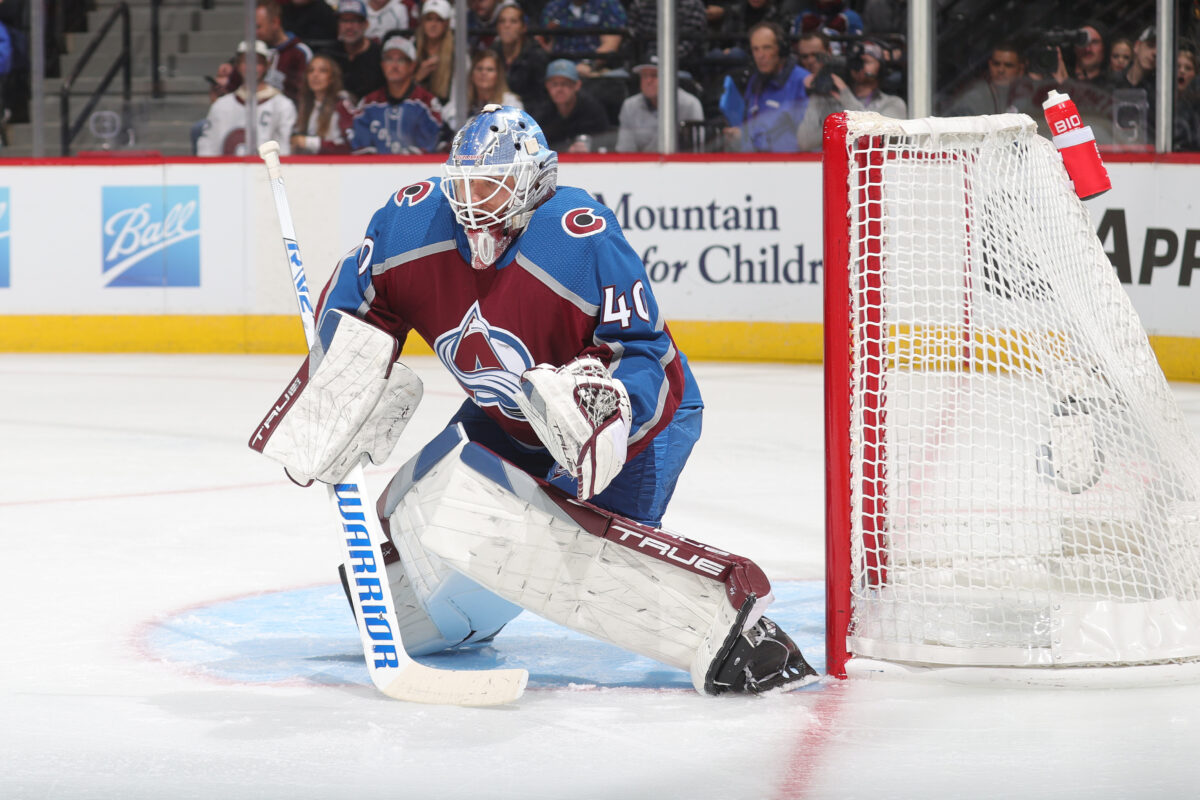Even after navigating an offseason in which they shed a ton of their forward depth, the Colorado Avalanche’s start to the 2022-23 season has been a relative disappointment. The 2021-22 campaign saw them miss out on the Presidents’ Trophy by a single point but were arguably the best team in franchise history. It’s unrealistic for any team to repeat such a performance to be sure, but the Avalanche’s results thus far are a far cry from that historic effort.
As the NHL calendar turns to December, the Avalanche are playing at a 105-point pace, which would be their lowest since 2018-19. That clip would be an outstanding season for most organizations, but it’s a step back for a group that has won the most games, scored the second-most goals, and compiled the highest points percentage in the NHL over the previous three seasons. Add in the revival of the Vegas Golden Knights and the Winnipeg Jets and, all of a sudden, the Western Conference looks much stronger than it did last season.
However, the Avalanche have reason to be excited despite the context of a more competitive slate of conference opponents and a noticeable absence of scoring depth. So, here are four reasons why the Avalanche should still be considered Stanley Cup favourites at the quarter-mark of the 2022-23 campaign.
Georgiev Enjoying Vezina Trophy-Calibre Season
After letting their Stanley Cup-winning goaltender Darcy Kuemper walk in free agency last summer, figuring out who would join Pavel Francouz in the crease became priority number one for the Avalanche. Alexandar Georgiev was chosen among an intriguing cast of potential leading men, and his play thus far suggests that general manager Chris McFarland made the right choice in pinning his hopes on the former New York Rangers netminder.
Despite coming off of multiple seasons marred by inconsistency, Georgiev has looked the part of a bonafide starting goalie with the Avalanche. He owns a record of 11-3-1 through 15 games, and his .922 save percentage (SV%) ranks ninth among goalies to have played at least five games this season, and fifth among those to have played at least 10.

Using goals saved above expected (GSAx), it appears as though Georgiev has significantly outperformed his workload. According to MoneyPuck’s model, the 26-year-old netminder has accumulated 6.8 GSAx, the eighth-highest mark in the league. When it comes to facing the most dangerous chances, Georgiev has continued to stand tall. Among qualified goalies (minimum five games played), he ranks 17th in high-danger SV%, placing him in the upper tier in terms of parrying shots from in and around the slot.
When a team boasts as much firepower as the Avalanche can muster, who stands between the pipes can often be an afterthought. Being able to outscore your problems expands your margin for error and the Avalanche is no slouch in that department. Even after seeing significant depth pieces in Andre Burakovsky and Nazem Kadri depart for greener pastures, they’ve converted at the seventh-highest rate this season, scoring 3.43 goals per game. Combine a potent offence with an impenetrable wall in the net and you’ve got a rather difficult team to crack.
Avalanche Challenging for Division Title Despite Injuries
Speaking of their potent offence, the Avalanche are lighting the lamp with regularity while being one of the most injury-afflicted teams in the league this season. According to NHL Injury Viz, the Avalanche rank fourth in cap hit of injured players (CHIP), a metric which represents the cumulative per-game cap hit of any players absent through injury or illness.
The obvious culprit for their dismal ranking is captain Gabriel Landeskog, yet to play this season as he recovers from offseason surgery. Adding to the CHIP ledger are several other key figures in Valeri Nichushkin (missed 14 games), Bowen Byram (11), and Samuel Girard (six). Between those three, Landeskog’s 21 games and counting, and with Evan Rodrigues recently hitting the shelf, it’s been a trying time in the Avalanche infirmary.
You may also like:
- Colorado Avalanche Won’t Be Contenders This Season
- Colorado Avalanche Lineup Projection for 2024-25
- Avalanche Giving Nikolai Kovalenko a Chance to Prove Himself
- 3 Avalanche Players With the Most to Prove in 2024-25
- Peter “Foppa” Forsberg: A Biography
Even with those absences testing the Avalanche’s depth, the defending champions have compiled a solid record despite the circumstances. As I alluded to before, their 13-7-1 record has them humming along at a pace good enough to challenge for the Central Division title. They’re only five points behind the Dallas Stars with three games in hand, and own the fifth-best goal differential in the NHL (plus-18). Teams have overcome bigger holes before, so just keeping within striking distance should be the goal for the Avalanche.
The Cup isn’t won or lost in November, but a team’s playoff hopes can certainly be extinguished with a poor stretch of games in the fall. The Avalanche have been, at worst, treading water while their lineup is in recovery mode and even that is downplaying how well they’ve fared thus far. The trade deadline is still several months away, but it represents another opportunity for the Avalanche to add a bona fide second-line center, especially as the internal candidates to replace Kadri have mostly struggled to do so early on in the campaign.
Avalanche Superstars Playing At High Level
Despite seeing their already thinning depth take an even greater hit early in the season, the Avalanche’s superstars have been unstoppable in their absence. Colorado’s triumvirate of Nathan MacKinnon, Mikko Rantanen, and Cale Makar are all firing at a point-per-game pace, and even Artturi Lehkonen (18 points in 21 games) and Devon Toews (14 in 19) have scored at elevated rates. MacKinnon (fourth) and Rantanen (sixth) both find themselves within the top 10 of forwards (minimum 10 games played) by points per game, with Rantanen sitting eighth in goals (14) and MacKinnon tied for first in assists (25).
On the defensive end, both Makar (fourth) and Toews (16th) rank in the top 20 of all defensemen by points per game (minimum 10 games played), although their production is being significantly enhanced by the power play (more on that later). However, they are playing heavy minutes at even strength (both are in the top 30 of defensemen by average even-strength ice time) while collectively holding their matchups at bay at 5v5.

As a pair, Toews and Makar have accrued 60.5 percent of the expected goals (xGF%) and 55.6 percent of scoring chances (SCF%), ranking sixth and 13th respectively out of 66 qualified duos (minimum 150 minutes played at 5v5). The two have also outscored opponents 12-8, which is respectable when considering the difficulty of their workload.
Using Makar’s most frequent matchups as a proxy for the pair’s workload, the forwards he has spent the most time on the ice against at 5v5 include Patrik Laine, Johnny Gaudreau, Jason Robertson, and Roope Hintz. Some of that is driven by the small sample of the season, but it demonstrates that with the aforementioned injuries to Byram and Girard, much of the heavy lifting at both ends has fallen at the feet of the Avalanche’s top defence pairing.
Despite the injuries, the team’s main stars have picked up the slack and dragged their hampered group near the top of the Central Division. It’s not surprising to see from the drivers of the Avalanche’s Stanley Cup run, but it still bodes well for their future outlook and the team is chugging along at full strength.
Avalanche Power Play Covering Up Weaknesses
It’s been established that the stars are driving the bus in Colorado but more specifically than that, their performance on the power play has covered up the team’s blemishes at 5v5, which are understandable given the extent of their injury list.
The Avalanche are currently sporting a sub-50 percent share of shots, expected goals, and high-danger chances at 5v5, teetering on the edge dividing the top and bottom half of the NHL. Their subpar even-strength play puts more pressure on their goalies and special teams to perform and fortunately for them, both have managed to post elite results to keep the Avalanche afloat.
In particular, the Avalanche power play is feasting on opposing penalty-kill units and ranks among the league’s best in terms of volume and efficiency. They lead the league in raw conversion (33.8 percent) and the difference between them and the second-place Boston Bruins (3.7 percent) is the same as the gap between the Bruins and the Buffalo Sabres, who rank eighth.
| Team | PP% | PP GF/60 |
|---|---|---|
| Colorado Avalanche | 33.8 | 12.7 (1) |
| Boston Bruins | 30.1 | 11.1 (4) |
| Dallas Stars | 30.0 | 12.2 (2) |
| Tampa Bay Lightning | 28.7 | 10.5 (5) |
| Edmonton Oilers | 27.6 | 11.3 (3) |
According to their underlying metrics, the Avalanche have adopted a quantity over quality approach to creating chances with the man advantage. On a per-60-minute basis, they rank third in shots and 11th in expected goals, but are 16th and 17th in scoring chances and high-danger opportunities respectively.
Only the Seattle Kraken (22.5 percent) and Tampa Bay Lightning (19.8 percent) are converting at a higher rate of their shots, but both are shooting much less often than the Avalanche. Both could be elite finishing groups, but their underlining lower volume suggests that they may instead be benefitting from a hot finishing run. When you’ve got as many players able to outperform their expected totals through their finishing abilities, launching as many shots on net as possible can be preferable to trying to craft the perfect chance.
Unsurprisingly, the Avalanche are managing to do just that, and rank first in the NHL in power-play goals per 60 minutes (12.66). Rate stats are a better indicator of efficiency since they account for how long their power play takes to get set up and capitalize. A team that only takes one minute on average to score is more effective than one that usually requires the entire two minutes. That’s where raw efficiency can be misleading but fortunately, the Avalanche are the league’s standard-bearers by both traditional and modern metrics for gauging power-play success.
Now, let’s use some crude research to show how crucial the power play has been to the Avalanche’s success this season. The Avalanche have lost the expected goals battle at 5v5 in 10 of their 21 games so far this season, but won on five of those occasions. Further, they won three of the six games in which they posted an expected goals share of 40 percent or lower. For reference, the NHL’s worst teams usually post an xGF% share of 45 percent or lower over an entire season. Isolated single-game results can be overly impacted by bad luck in such a small sample, but it still goes to show how often the Avalanche have been out-chanced at 5v5 this season.

The Avalanche scored two or more power-play goals in three of those 10 games (all wins), and at least one goal with the man advantage in eight out of 10 games. Also, four of the five wins in which they posted a sub-50 percent expected goals share came in games where they scored at least once on the power play.
The Avalanche are not the first team to rely on a combination of elite goaltending and strong special teams to achieve success, and they won’t be the last. The risk is that both are susceptible to swings in variance and that a team’s performance at 5v5 is more indicative of their results in the long term. For now, the Avalanche can point to their bloated list of injuries and hope that getting back to full health coincides with a return to dominance at 5v5 and be thankful that power-play prowess is the great equalizer.
Avalanche Are Capable of Repeating as Stanley Cup Champions
There’s no point in denying that the first two months of the 2022-23 season haven’t been smooth sailing for the Avalanche. They’ve been hit with a barrage of injuries and struggled with consistency as support players have been forced to play out of their depth. Still, the old adage goes that playoff results are all that matters and this team can survive the slog of the regular season before becoming fully healthy at the right time of year.
The journey may be rocky, but the Avalanche roster is full of hardened veterans with experience navigating turbulent times. Of course, the Avalanche have been far from their best, but digging into the underlying causes paints a much rosier picture for the defending Stanley Cup champions.
All things considered, the rest of the league should still be wary of the NHL’s latest dynasty hopefuls. Whether they actually do repeat is a moot point, but for now, they should retain their status as a leading NHL power broker. Best of luck to those who underestimate the NHL’s wounded apex predator.
Data courtesy of MoneyPuck, Natural Stat Trick, and the NHL.